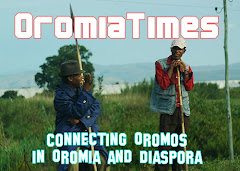U.S. Conspiracy in federating Eritrea with Ethiopia says Shaebia
Wednesday, 1 February 2006, 9 hours, 14 minutes and 15 seconds ago.
By andnetwork .com
In late 1940s, during the discussions for the disposal of former Italian colonies, the Eritrean case gained the attention of the Great Powers and the world in general. This was because of their strategic interest. Their interest resulted in the complication of Eritrea’s case. In this article we will see United State’s interest and her role in the Eritrean case.
According to Article 23 of the Peace Treaty with Italy signed in 1947, the future of former Italian colonies (FIC) was to be determined jointly by the governments of US, USSR, UK and France. However, there was no sprit of accord among the western powers concerning Italian colonies. The Soviet Union favored Italian trusteeship; her position was mainly intended to give support to the election of the Italian Communist party. The British’s position was the cessation of southern Eritrea to Ethiopia and the northwest part to Anglo-Egyptian Sudan. The French, fearing the effects of the Arab nationalism on the inhabitants of French North Africa, favored the returning back of Italy to her former colonies, whereas the United States desired the cases of the FIC to be considered individually on territorial bases. Consequently the case was referred to the General Assembly of the United Nations.
The United States had had strong strategic interest on Eritrea. Eritrea was seen as an important site for strategic radio facilities. The US maintained an Army signal station at Asmara serving a large part of the Middle East. Above all US resisted any decision, which would give Soviet Union control over not only on the former Italian colonies but also over the entire Middle East. As a matter of fact the Eritrean case was more seriously regulated than the other Italian colonies that were to be disposed of. According to a Memorandum dated April 16, 1946, President Roosvelt asked the Secretary of State to submit recommendations regarding disposition of Italian colonies on April 28, 1944. Consequently the Inter-Divisional committee on Africa submitted the recommendations that we see in the following paragraphs.
The Memorandum sent by the Department of State on September 27, 1948 to the U.S delegations to the Assembly of the United Nation states that “ the delegation should propose the cession to Ethiopia of the southern section of Eritrea including the Denakil coast and the districts of Akele Guzai and Serae and the decision on the northern part to be postponed for at least one year.” The State Department defined the new boundary of the southern part to start with the Gulf of Zula and follow the northern borders of Akele Guzai and Serae districts to the Ethiopian frontier. The reasons for the postponement of the decision on the northern part were in order to facilitate the returning back of Italians formerly residents of Eritrea, the divergent opinions among Eritreans and the western powers and the strategic requirement of American military facilities at Asmara.
The alternative proposals, if the proposals stated above were not approved, were the cession of all Eritrea to Ethiopia in full sovereignty, if not Ethiopian trusteeship over the whole territory. These proposals were based on the positions taken by the United States in the Council of Foreign Ministers since, according to the memorandum, the positions affect the interest of America especially in the case of northern Eritrea and is also based on the recommendation of the National Security Council approved by U.S. president. The proposal for the partition of Eritrea and the need to affiliate southern Eritrea with Ethiopia was to give Ethiopia access to the sea and the cultural and religious similarities between the people of highland Eritrea and Ethiopia. According to the memorandum the partition of Eritrea appeared reasonable because of equal division between Coptic and Moslem sections of the population. The recommendation to the cession of all Eritrea to Ethiopia was to satisfy Ethiopian demands so that to help counter-balance the return of Italians to Somaliland, and to gain the approval of the small nations- considering the decision as an act of justice.
The United States and the British government came out with an agreement of supporting the ceding of all of Eritrea, with the exception of the Western province. If this proposal was accepted by the General Assembly, it was agreed that Ethiopia would give guarantees of “minority rights” and the returning of former Italian settlers. Regarding the Western province, being inhabited by majority Moslems who oppose union with Ethiopia, became complicated. The British government changed its first proposal, which it presented in the Council of Foreign Ministers, and refused to support the affiliation of Western province with Anglo-Egypt Sudan. However, the US insisted on the ceding of the Western Province to Sudan. This was because in the eyes of US officials the western province had no strategic or commercial value and was not qualified for independence.
During the meetings of the General Assembly from September to December 1948, the positions of both Britain and United States were-
(a) Italian trusteeship for Italian Somaliland
(b) Cessation to Ethiopia of all of Eritrea except the Western Province
(c) Disposition of the Western province to be studied by the trusteeship Council during the following year.
During these meetings the UK and the US worked hard to win over the support of other member states, since in order the proposal to be approved it was necessary to receive two-thirds vote in the General Assembly.
The delegations of the Ethiopian government attempted to gain support from the US government. In return Ethiopia promised to grant US military facilities after the area was ceded to Ethiopia. The Emperor of Ethiopia Haile Selassie visited President Roosevelt at Great Bitter Lake in early 1945 and he forwarded his claims of Eritrea and Italian Somaliland. Ethiopian delegation’s visit and diplomatic efforts were most welcomed by US officials. According to the Memorandum sent for the Secretary of Defense (5 Aug 1948) by the Joint Chiefs of Staff, some of the strategic requirement were denials of any potentially hostile power of any foothold in the area, maintenance of friendly relationship which can be promoted by social and economic assistance together with military assistance, etc. United States had to support Ethiopia in order to maintain friendly relationship. In addition, the Memorandum stated, “as the nature of the rights in Eritrea, …the benefits now resulting from operation of our telecommunications center at Asmara…can be obtained from no other location in the entire Middle East…Therefore, US, rights in Eritrea should not be compromised.” Finally, the United States Chief of Staff proposed the adoption of those places in case the proposals were rejected.
To conclude, the United Nations is an organization, which is still working to safeguard the interest of Great Powers, leaving aside the goals of its establishment, which is serving for peace and human dignity. What mattered in the disposal of the Former Italian Colonies was not the wishes and welfare of the inhabitants as stated on the declaration of the Four Powers Peace Treaty with Italy but rather it was the strategic interest of the Great Powers. After World War II, on the bases of bilateral agreement with Emperor Haile Selassie, United States engineered a UN sponsored federation between Eritrea and Ethiopia in exchange for a twenty-five-year lease on the base in Asmara and use of port facilities of Massawa. Consequently Eritrea was federated with Ethiopia. The emperors of Land-locked Ethiopia historically coveted Eritrea’s Red Sea ports, but were never able, totally, to capture them. The United Nations gave Ethiopia what she had never been able to win by force of arms.
Up to 1976 the United States poured more than $600 million aid-50 percent for military purpose- into Ethiopia as payment for the base. This aid was later used by the Dergue to purchase substantial arms for use in the war on Eritrea, specifically for bombing and massacring civilians. However, regardless of the superiority of Ethiopian government in military terms, the Eritreans won the thirty years bloody war. After the war was ended the UN and the US accepted the independence of the new nation. Nevertheless, in May 1998 a war broke out between Eritrea and Ethiopia. This war, which costed a lot of human lives, was concluded after two years by a peace treaty in Algiers.
In this treaty the case of Eritrea and Ethiopia was forwarded to an international law court that established a Border Commission (Eritrea-Ethiopia Border Commission-EEBC). In the treaty, it was agreed that the judgment would be Final and Binding and a sanction would be imposed on the one who does not abide by the judgement. The United States, European Union, United Nations, African Union, Algeria, signed to guarantee the peace treaty. Accordingly on April 13th 2002 the Permanent Court of Arbitration in the Hague announced its Final and Binding conclusion. Despite the fact of the agreement- to abide by whatever the EEBC’s decision- Ethiopia rejected the judgement describing it as “unjust and illegal”. Ethiopian refusal of the decision dimmed the hope of peace. According to the Algiers Treaty, the international community, specially the United States who is one of the guarantors, instead of imposing sanction on Ethiopia, is indulging and encouraging her to resume her lawless action - repeating the history of conspiracy of federating Eritrea with Ethiopia.
Source : Shaebia
Subscribe to:
Post Comments (Atom)

















No comments:
Post a Comment